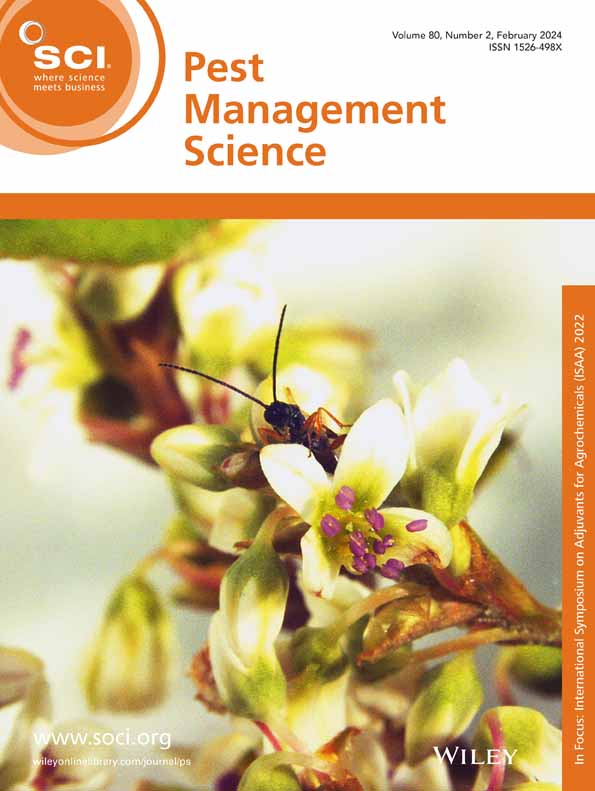与意大利大鼠和小鼠抗凝血药抗性相关的Vkork1基因新多态性
IF 3.8
1区 农林科学
Q1 AGRONOMY
引用次数: 0
摘要
背景:抗凝血灭鼠剂是防治鼠害的有效手段。然而,在世界范围内都有记录显示耐药性。ARs阻断维生素K的循环,导致动物内出血死亡:Vkorc1基因突变可引起耐药性。抗AR啮齿动物的传播可能导致其种群数量的增加,伴随的人畜共患病原体的扩散,并增加非靶动物对AR的暴露,因此广泛研究其扩散具有重要意义。本研究首次报道了意大利艾米利亚-罗马涅地区合群啮齿动物中存在的Vkorc1突变,并通过分子对接分析评估其在耐药性中的作用。结果共检测动物67只,其中褐家鼠24只,家鼠35只,小家鼠8只。在6/8只小鼠、13/24只褐家鼠和10/35只家鼠的密码子分别在128和139、61和139和59上检测到与AR抗性相关的单核苷酸多态性(snp)。此外,在所有被测试的物种中都检测到一些新描述的错义突变:分子对接分析表明其中一些突变(例如I123S和F87L)在大鼠和小鼠中对溴代菌的抗性中起作用。结论43.28%的检测鼠类中发现耐药性snp,为我们敲响了警钟,需要采取综合防治措施,不常规使用AR,而是进行具体的监测评估。©2024作者。《病虫害管理科学》由John Wiley &出版;我代表化学工业协会的儿子有限公司。本文章由计算机程序翻译,如有差异,请以英文原文为准。
New polymorphisms of Vkork1 gene related to anticoagulant resistance of rats and mice in Italy
BACKGROUNDAnticoagulant rodenticides (ARs) are a very effective tool to control rodent pest populations. Nevertheless, AR resistance has been documented worldwide.ARs block the cycle of vitamin K, leading to the death of the animal by internal bleeding: mutations in Vkorc1 gene can cause resistance.The spreading of AR‐resistant rodents could lead to an increase of their populations, the associated diffusion of zoonotic pathogens, and to the amplified exposure of non‐target animals to ARs, thus it is important to study its diffusion widely. This study aimed to report firstly the presence of Vkorc1 mutations in synanthropic rodents from the Emilia‐Romagna region, Italy, and evaluate their role in resistance by means of molecular docking analysis.RESULTSA total of 67 animals were analyzed: 24 Rattus norvegicus , 35 Rattus rattus and eight Mus musculus . Single nucleotide polymorphisms (SNPs) associated with AR resistance, in homozygosis or heterozygosis, were detected in 6/8 mice, on codons 128 and 139, and 13/24 R. norvegicus , on codons 61 and 139, and in 10/35 R. rattus , on codon 59. Furthermore, several newly described missense mutations were detected in all the tested species: the molecular docking analysis suggests a role of some of these (e.g., I123S and F87L) in resistance to brodifacoum, both in rats and in mice.CONCLUSIONThe discovery of AR resistance SNPs in the 43.28% of tested rodents sounds as an alarm bell that requires the introduction of an integrated control approach, where ARs are not used routinely, but under specific monitoring evaluation. © 2024 The Author(s). Pest Management Science published by John Wiley & Sons Ltd on behalf of Society of Chemical Industry.
求助全文
通过发布文献求助,成功后即可免费获取论文全文。
去求助
来源期刊

Pest Management Science
农林科学-昆虫学
CiteScore
7.90
自引率
9.80%
发文量
553
审稿时长
4.8 months
期刊介绍:
Pest Management Science is the international journal of research and development in crop protection and pest control. Since its launch in 1970, the journal has become the premier forum for papers on the discovery, application, and impact on the environment of products and strategies designed for pest management.
Published for SCI by John Wiley & Sons Ltd.
 求助内容:
求助内容: 应助结果提醒方式:
应助结果提醒方式:


